The Severum Cichlid is an old aquarium favorite that has been a part of the hobby since the 1800’s. From South America, these cichlids grow to an impressive size. Yet they remain mild tempered and get along well with most community aquarium fish.
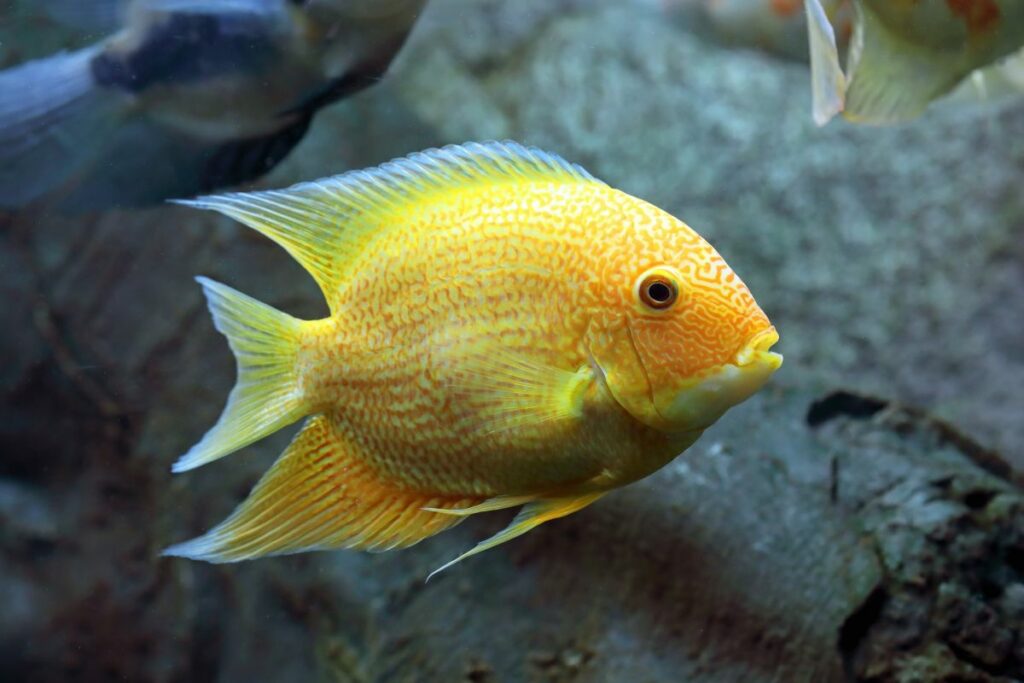
Severums also come in several color varieties and even a few different species that enter the hobby sometimes. If you are looking for a cichlid that’s less aggressive and gentler on your decorations then the Severum Cichlid might be right for you.
What is the Severum Cichlid?
The Severum or Banded Cichlid is a medium sized cichlid from South America, found in the Upper Orinoco and Rio Negro river basins. These fish is a member of the Heros efasciatus species complex.
Meaning that there are a number of similar looking fish that are included under the scientific name that are all close relatives. Wild caught Banded Severum Cichlid fish will vary a lot in appearance as a result. And the different species will interbreed with each other if given the chance.
Severum Cichlids are unusual because they are one of the few cichlids that are not just partial vegetarians but frugivores. Meaning they eat fruit at times. But just during the flood season, where their home rivers extend into the surrpounding rainforest.
Fruit from trees falls into the water and softens. Such a bounty of fruit provides food for Severum Cichlids, Pacu, Silver Dollars, and other opportunist fruit eaters.
- Common Names: Severum, Banded Cichlid, Green/Gold Severum, Rainbow Severum Cichlid, Turquoise Severum Cichlid
- Scientific Name: Heros efasciatus
- Origin: Upper Orinoco & Rio Negro River Basins
- Length: 8 inches
- Aquarium Size: 40+ Gallons
- Temperament: Semi-Aggressive
- Ease of Care: Easy
Severum Cichlid Species
The Green Severum Cichlid is by far the most common Severum Cichlid species you’re going to find in pet stores. But there are a number of color varieties and separate species that exist. The Gold Severum Cichlid is the second most common type. Its warm yellow background with bright orange scales are a nice change from the more subdued colors of wild-type severums.
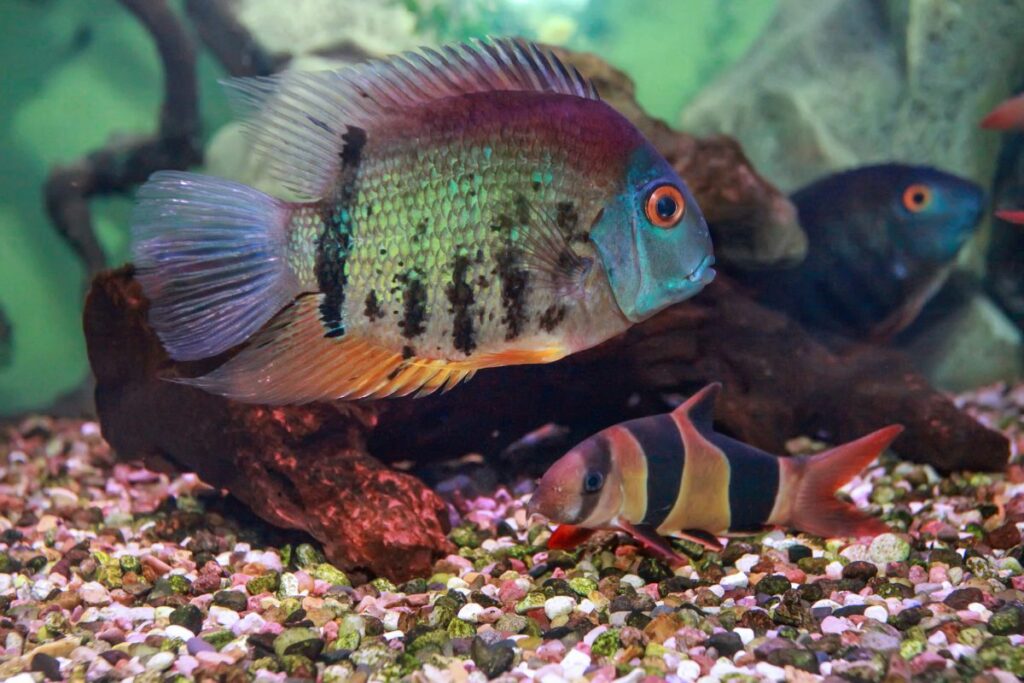
That said, the genus Heros includes more than one fish. The Redhead Severum Cichlid is an uncommon but interesting fish, also known as Heros cf. efasciatus. Also known as the Red Shoulder Severum Cichlid, it has bright red tones behind its gill covers and a more vibrant green color.
Most Redhead Severum Cichlid fish are wild caught so they tend to be sensitive to ammonia and other pollutants. Should you breed Red Shoulder Severum Cichlids, you will find captive bred babies to be in high demand as they are rare.
Severum Cichlid Care
Severum Cichlid care is easy because these medium sized cichlids are uncomplicated and hardy. The majority are captive bred and thrive in a wide range of water conditions. Severums also eat anything that is offered to them and have a mild temperament.
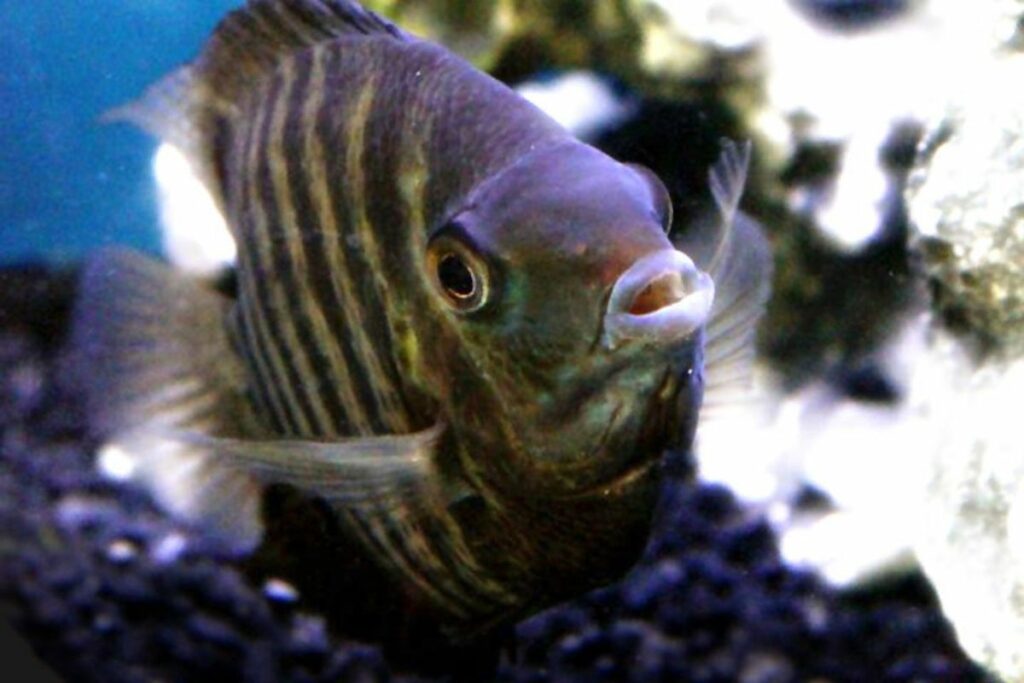
Full Grown Severum Cichlid Tank Size
Severum Cichlid size is in the medium category; not the largest of cichlids but not the smallest, either. A full grown Severum Cichlid will be around 8 inches long. When young you could keep them in an aquarium as small as 20 gallons. But an adult should live in at least a 40 gallon breeder fish tank, with 55 gallon aquariums being the most comfortable.
Plants and Substrate
Unlike many cichlids the Banded Cichlid is not as big on digging and destroying plants. Severums have such small mouths that they have a hard time moving the substrate around too much.
A breeding pair of Severum Cichlids will do some digging but not a lot. They won’t pull up your aquarium plants, either. Therefore the Severum a good choice for planted aquascapes.
They do need a hard surface when preparing to spawn, however. If you provide your Severum Cichlids with a nice, flat rock or piece of driftwood they won’t disturb your substrate much.
Cichlid Severum Water Conditions
Like most South American fish the Green Severum prefers neutral to somewhat acidic conditions (pH 6.0-7.0). But the vast majority are raised in captivity these days. So they will tolerate alkaline water (pH 7.0+) but won’t show best color or breed in it.
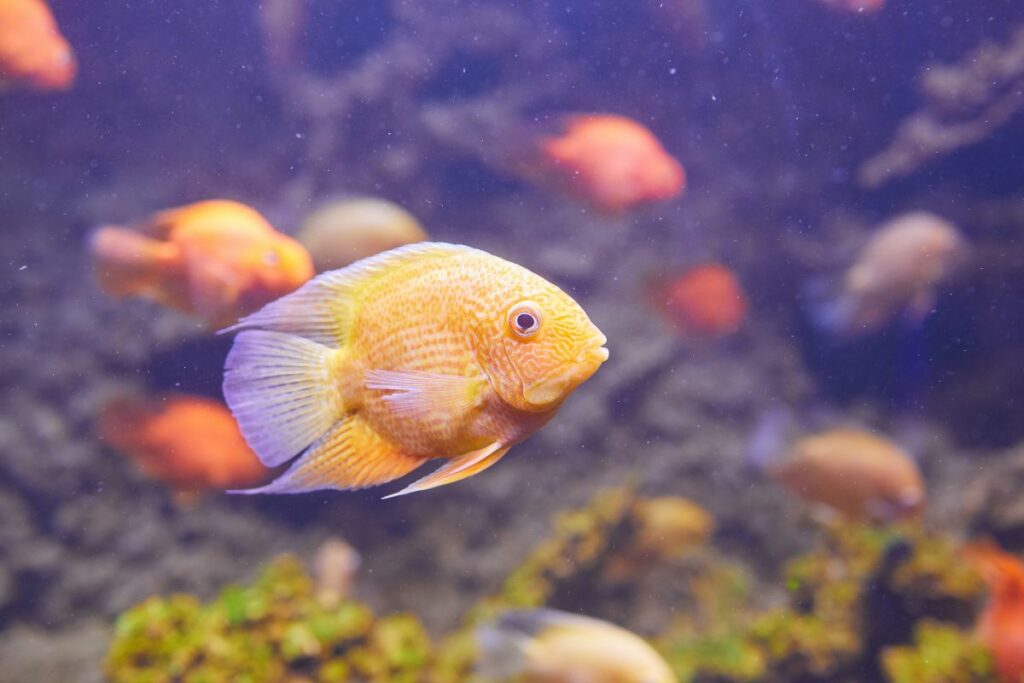
Severums are also quite hardy and resistant to elevated levels of ammonia, nitrite, or nitrate. But make sure you perform regular filter maintenance and water changes anyway. Even small amounts of nitrogenous waste still causes fish stress, reduces their appetite, and lowers disease resistance.
The water temperature should be somewhat warm because Severums are found close to the equator. 75-80°F is best for a Banded Cichlid. And if your Severum gets ich or you want to breed these fish, you should raise the water temperature to 82-85°F.
By increasing the water temperature you increase the metabolism of your fish. You will help them fight off infections – or find themselves in the mood to spawn much faster.
Green Severum Cichlid Tank Mates
Severum Cichlids are semi-aggressive in temperament but it depends a lot on the personality of your individual fish. Some are meek, others are peaceful, but sometimes you will get a Severum that hates everything.
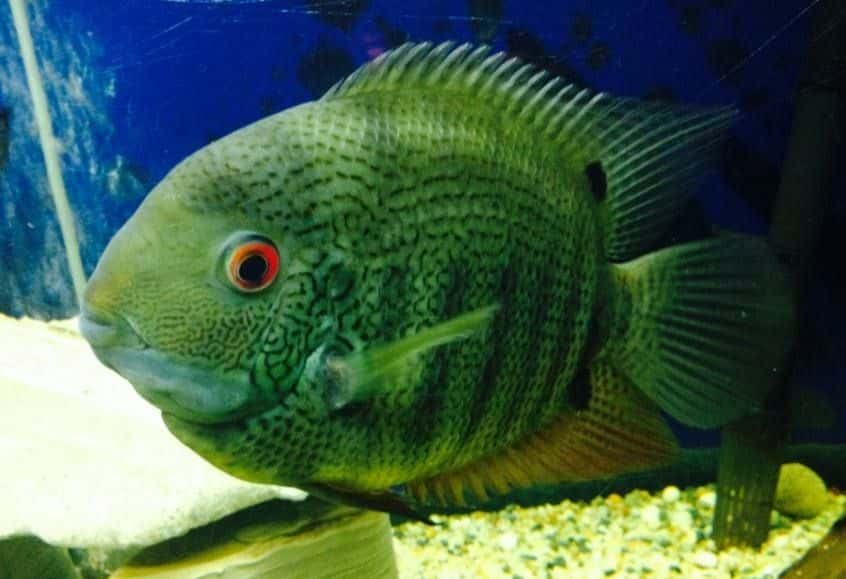
The majority will not bother other fish as long as the tank is spacious enough for the Severum to have its own living space.
Other large peaceful to semi-aggressive fish are the best Severum tank mates. These include a large number of common community aquarium fish. Gouramis, Rainbowfish, Barbs, Congo Tetras, Molly fish, Hatchetfish, and Giant Danios are just a few choices to consider.
Smaller fish like Guppies, Tetra Fish, and Danios are a match in terms of temperament. But an adult Cichlid Severum is large enough to try eating these small tank mates.
Bottom dwelling fish like Cory Catfish, Clown Loaches, and Plecostomus all get along well with Severums.
You could also keep a Severum Cichlid in a mixed cichlid community tank. Make sure you pick cichlids that are just as mild mannered as they will be bullied by aggressive species. Good matches include Oscar fish, Angelfish, Chocolate Cichlids, Electric Blue Acaras, Keyhole Ciclids, and Kribensis.
Feeding the Green Severum Cichlid
The Green Severum Cichlid is omnivorous, feeding on both plant and animal matter. They eat more animals than plants, however. Small worms, aquatic insects, shrimp, snails, fish eggs, and small fish are all on the menu.
And if there are no animals to eat a Severum Cichlid will turn to soft aquatic plants and filamentous algae. They are also one of the few cichlids that will eat fruit that falls into the water and softens over time.
A mixed diet full of variety is therefore essential to the health of a Severum Cichlid. A standard high quality cichlid food with whole ingredients like spirulina, fish meal, krill, etc, is a good start.
And build on this diet with a selection of frozen foods like brine shrimp, tubifex worms, blood worms, and other items. Even a full grown Severum Cichlid will eat brine shrimp with gusto.
Breeding Severum Cichlids
The Green Severum Cichlid, like most cichlids, is a model parent when it is time to breed. They take good care of their eggs and young. A pair of Severums will fan the eggs with their fins to oxygenate them. And once the fry hatch they will do their best to defend them from other fish in the tank.
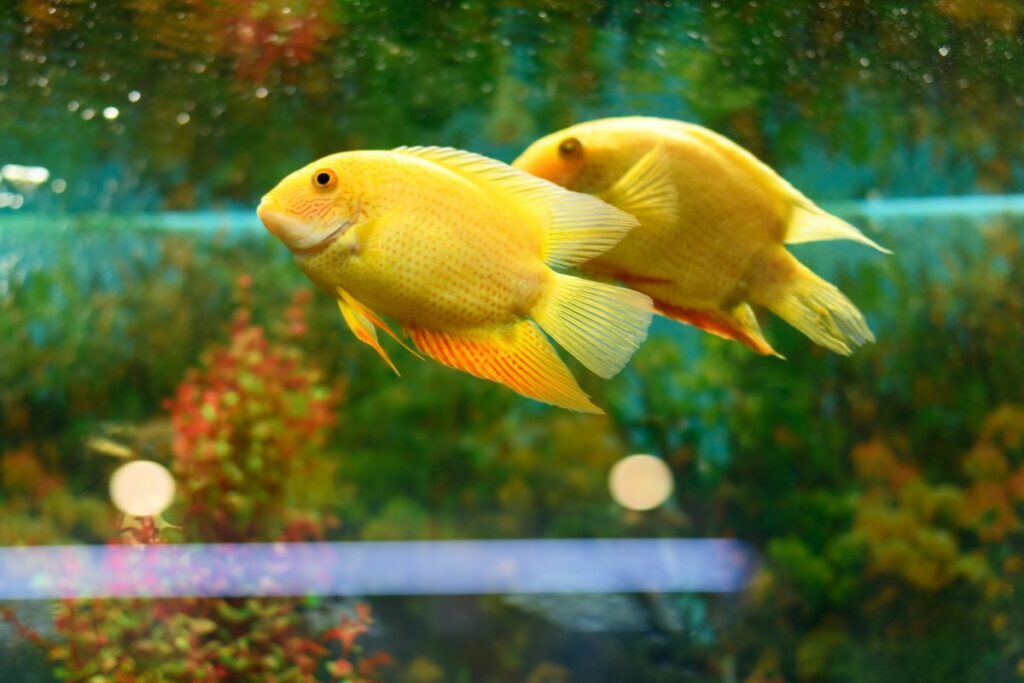
The first step to breeding Severum Cichlids is to tell apart males from females. The differences are a little subtle as the Severum Cichlid colors of both sexes are very similar. Neither males nor females are brighter or more colorful than the other.
That said, an adult male cichlid Green Severum will have colorful squiggles on his cheeks (gill covers) under his eyes. He will be larger in size than a female of the same age. Plus his dorsal and anal fins will have distinctive points.
Female Severum fish don’t have colored squiggle-like markings on their gill covers. Their dorsal and anal fins are also more rounded than an adult male’s fins.
The best way to get a pair is to raise six or so together in a spacious aquarium. A pair will form over time as the fish grow up together. Once you have your pair, you should move the mature fish to a breeding tank of their own.
As long as you maintain proper temperature, water chemistry, and offer a variety of nutritious food, spawning is inevitable. Severums lay thousands of eggs at a time and take good care for them.
Conclusion
The Severum Cichlid is a favorite for aquarists all around the world. It has enough cichlid personality to satisfy newcomers to these fish. Yet they aren’t so aggressive that they bully their tank mates. Severums also grow to be impressive in size – yet remain manageable enough for the average fish hobbyist to care for one.
More Frequently Asked Questions About the Severum Cichlid
Severums have been a part of the aquarium hobby for many decades. But sometimes I get a few additional questions on how to care for these showy, peaceful cichlids. Here are some of the most frequently asked ones for you to consider.
The Heros Severum cichlid is a medium sized fish. At 8 inches long full grown they are not too large but not small, either.
Captive bred Severum Cichlids are very hardy and long lived. Red Shoulder Severum fish are a little sensitive because they are almost always wild caught, however. They need cleaner water conditions than tank bred Severums do.
Severum Cichlids are gentle in temperament, as far as cichlids go. So make sure you choose cichlids that are equally gentle. They will be bulled by Red Devils, Jack Dempsies, and even Convict Cichlids. Angelfish, Geophagus, Chocolate Cichlids, and Blue Acaras all get along well in a community of more peaceful cichlid fish.

